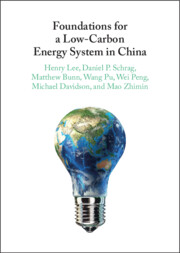Book contents
- Foundations for a Low-Carbon Energy System in China
- Foundations for a Low-Carbon Energy System in China
- Copyright page
- Contents
- Acknowledgments
- 1 Introduction
- 2 Reforming China’s Electricity Market to Facilitate Low-Carbon Transition
- 3 Promoting Large-Scale Deployment and Integration of Renewable Electricity
- 4 Enabling a Significant Nuclear Role in China’s Decarbonization
- 5 Transitioning to Electric Vehicles
- 6 From Barrier to Bridge
- 7 Coordinating Strategies to Reduce Air Pollution and Carbon Emissions in China
- 8 Conclusion
- Index
- References
6 - From Barrier to Bridge
The Role of Coal in China’s Decarbonization
Published online by Cambridge University Press: 02 December 2021
- Foundations for a Low-Carbon Energy System in China
- Foundations for a Low-Carbon Energy System in China
- Copyright page
- Contents
- Acknowledgments
- 1 Introduction
- 2 Reforming China’s Electricity Market to Facilitate Low-Carbon Transition
- 3 Promoting Large-Scale Deployment and Integration of Renewable Electricity
- 4 Enabling a Significant Nuclear Role in China’s Decarbonization
- 5 Transitioning to Electric Vehicles
- 6 From Barrier to Bridge
- 7 Coordinating Strategies to Reduce Air Pollution and Carbon Emissions in China
- 8 Conclusion
- Index
- References
Summary
Rapid economic growth in China has predominantly relied on coal-fired electricity and coal use in industry, generating an increasing range of economic, environmental, and health costs. While many policies aim to restrict – and reverse – coal’s growth, the transition from coal to low-carbon alternatives is neither automatic nor just around the corner. Entrenched technological systems, political interests, and historical factors serve to maintain coal’s dominance. For China to prepare for deep decarbonization by mid-century, it must proactively convert coal from a barrier to a bridge – productively repurposing and valuing coal assets for flexible operation, addressing the difficult coal-based district heating infrastructure in the north – develop alternative fuels and feedstocks for industry and households, and mitigate the immense socioeconomic consequences of this transition on governments, firms, and workers.
Keywords
- Type
- Chapter
- Information
- Foundations for a Low-Carbon Energy System in China , pp. 121 - 156Publisher: Cambridge University PressPrint publication year: 2021



